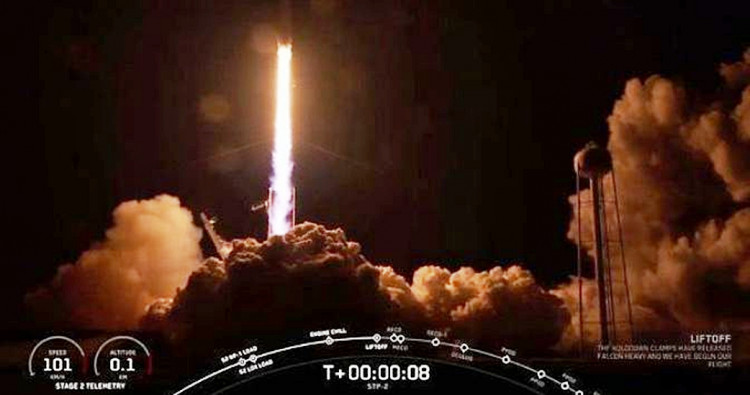SpaceX successfully pulled-off its most difficult mission to date, launching a Falcon Heavy rocket carrying 24 spacecraft and the cremated remains of 152 space enthusiasts sent into orbit by their families.
Launch mission USAF STP-2 (Space Test Program-2) from Cape Canaveral, Florida was also the first night launch for this super-heavy launch vehicle standing 229 feet tall that first flew in February 2018.
The world's most powerful rocket blasted off at 2:30 EDT on June 25 powered by the main core and two side-boosters (or side-cores) used on the mission that successfully orbited the Arabsat 6A satellite on April 11. The main core was a new machine.
SpaceX CEO Elon Musk described Tuesday's mission as one of the most difficult yet for SpaceX. This, because the Falcon Heavy had to perform a number of complex maneuvers. These included four separate upper-stage engine burns and three separate deployment orbits. Total mission duration came to over six hours.
STP-2, which was managed by the Air Force Space and Missile Systems Center, was the Pentagon's first use of a Falcon Heavy. The mission was called "one of the most challenging missions Space and Missile Systems Center has ever launched," according to Col. Robert Bongiovi, director of the Air Force Launch Enterprise Systems Directorate.
"We're putting 24 research and development satellites into three separate orbits, with a first-ever four engine start and burn off the second stage."
Col. Bongiovi said the use of the previously-flown side-boosters is providing critical insight into reusability and quality assurance that will allow the military to provide space access in a more cost-effective and expedient manner.
USAF STP-2will help certify Falcon Heavy for launching expensive high-priority national security payloads. Falcon Heavy's next mission, AFSPC-52, will be for the U.S. Air Force. It will carry a classified payload into orbit in the third quarter of 2020.
The STP-2 payloads were stacked in a dispenser inside the Falcon Heavy's nose fairing. They included an ultra-accurate atomic clock NASA is testing to improve deep space navigation; six satellites sponsored by the National Oceanic and Atmospheric Administration and Taiwan that will help improve tropical weather forecasting and experimental propulsion technology provided by NASA that uses less-toxic but more powerful "green" propellants.
Twelve small "Cubesats" were also on board. The most intriguing of these is a three-unit (3U) CubeSat from the Planetary Society that will test solar sail or lightsail technology, which uses the pressure of sunlight for propulsion.
The solar sail will unfurl to the size of a boxing ring and catch enough sunlight to climb some three-tenths of a mile per day without the use of traditional thrusters and propellant.
"It's really a romantic notion that has tremendous practical applications," said Bill "The Science Guy" Nye, CEO of the Planetary Society.
"We share the technology with the world, and we are very excited about this launch because we're going to get to a high enough altitude ... that we're really going to be able to build orbital energy and take some, I hope, inspiring pictures."
Several built by students will study how Earth's magnetic field and charged particles in the near-space environment affect sensitive electronics and communications. Also aboard the mission are small portions of the cremated remains of 152 space enthusiasts sent into orbit by their families through Celestis Memorial Spaceflights. This company provides launch opportunities for clients who want burials in space.






